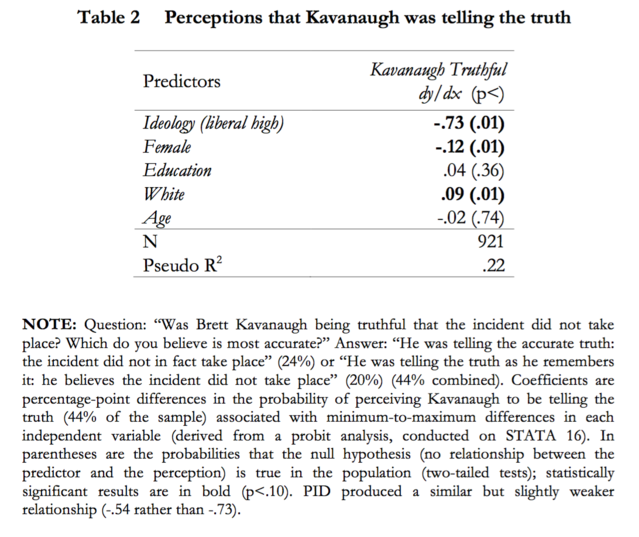Deception
Disperceptions of the Ford-Kavanaugh Hearings and Ideology
Part II: Perceptions of lying.
Posted November 30, 2020 Reviewed by Lybi Ma
Perhaps the most important question in this research on the Ford-Kavanaugh controversy was about Kavanaugh’s veracity. The heart of the public issue was Kavanaugh’s suitability to be a Justice of the Supreme Court. Was this man lying about the accusation of sexual assault?
Respondents to the nationally representative survey were asked:
“Was Brett Kavanaugh being truthful that the incident did not take place? Which do you believe is most accurate?”
1. He was telling the accurate truth: the incident did not in fact take place (24 percent)
2. He was telling the truth as he remembers it: he believes the incident did not take place (20 percent)
3. He was lying: he knows an assault took place (32 percent)
4. Do not have an opinion (25 percent)
Nearly two years after the hearings when Ford and Kavanaugh offered their opposing stories for a national audience, Americans remain deeply divided over Kavanaugh’s veracity. Around a third said he was lying. About a quarter responded that he was telling the truth and another 20 percent that he was telling the truth as he remembers it. And another quarter did not offer an opinion.
What are the factors related to perceptions of Kavanaugh’s truthfulness? What leads observers to conclude he was lying or telling the truth?
To examine these perceptions and their potential origins a bit further, we can look at their connection to other beliefs such as political ideology or partisan identity, as well as demographic variables such as gender, race, and education.

Variables in the analysis include ideology (1) or partisan identity (2), gender (3), education (4), race (5), and age (6).
Most of the variables are scaled 0 to 1 to present the effect of moving from the lowest to highest value along the range. For example, the effect of ideology in the table is from moving strong conservative (0) to strong liberal (1.0).
The dominant driver of perceptions is clearly ideology, with strong liberals 77 percent more likely than strong conservatives to believe Kavanaugh was lying. Surprisingly, gender is not independently related at all to these perceptions. It is liberal women, not women as a whole, who perceive lying.
An alternative way of conceptualizing this is partisan affiliation rather than political ideology. In contemporary politics, the two are deeply related (correlation .66 in these data) but somewhat distinct in the sense of one being the belief system and the other the group attachment that leads to partisan cheerleading. The influence of PID on perceptions is similar but slightly smaller (.62 rather .77), suggesting that the partisan lens is strong but the ideological lens slightly stronger.
Education and age also play independent roles, with the most-educated people 11 percentage points more likely than the least to perceive Kavanaugh as lying and older people 22 points more likely than younger ones.
What about the opposite perception, that Kavanaugh was telling the truth?

Regarding perceptions that Kavanaugh was being truthful, the influence of ideology is similar to perceptions of dishonesty (73 percentage points) in the opposite direction (liberals were far less likely, and conservatives far more likely to believe Kavanaugh was telling the truth). Gender does play a strong independent role in this perception beyond the role of ideology, with women 12 percentage points less likely to think Kavanaugh was being honest. White respondents were 9 percent more likely to perceive truthfulness (and minorities 9 percent less likely).
The complexity of this case—with possible nuances beyond just the two options of lying and accuracy—suggest that we should break down the analysis of the two options for perceptions of Kavanaugh’s honesty: A) that he was telling the accurate truth, and B) that he telling the truth as he remembers it (and hence was not lying but perhaps not accurate either). Do the two perceptions of honesty have different connections to ideology or demographics?


The two versions of perceiving Kavanaugh to be telling the truth clearly bear two different relationships to political ideology. Perceiving him to be telling the accurate truth is clearly driven by ideology (with conservatives 60 percentage points more likely to take this position than liberals). But perceiving the softer version of telling the truth (as he remembers it) is not driven by ideology nearly as much (16 points rather than 60 separating conservatives and liberals).
In regard to gender, women are 11 points less likely to perceive accurate truth, while perceiving Kavanaugh to be telling the truth as he remembers it is unconnected to gender.
Older people somewhat more likely to perceive full truthfulness, but 9 percentage points less likely to see the other version of truthfulness; seeing perspectival truth is a younger person’s perspective.
Perceiving him to be telling his own believed truth is also connected to being more highly educated and white. Soft truth may be less of an apparent option for minorities or those who have not heard that idea during higher education.
With several nuances, the disperceptions of Kavanaugh’s veracity remain deeply divided and deeply ideological.
References
Note (1): Very liberal 12.3%, Liberal 19.5%, Moderate 28.9%, Conservative 19.6%, Very Conservative 11.8%; scaled 0-1.
Note (2): Strong Democrat 25.2%, Democrat 11.3%, Leaning Democrat 9.4%, Independent 14.6%, Leaning Republican 8.7%, Republican 7.5%, Strong Republican 19.3%; scaled 0-1.
Note (3): Female 56%, Male 44%.
Note (4): 1=no high school 2.8%, 2=high school 29.4%, 3=some college 22.5%, 4=2 year degree 10.0%, 5=4 year degree 22.1%, 6=post-grad 13.2%; scaled 0-1.
Note (5): White 73.9%, Black 8.3%, Hispanic 9.2%, Asian 2.9%; white = 1, all else = 0.
Note (6): 18-29 13.2%, 30-44 28.0%, 45-64 39.0%, 65+ 19.8%; scaled 0-1.




